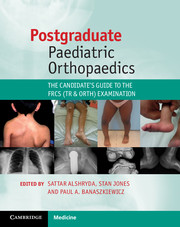Book contents
- Frontmatter
- Contents
- List of contributors
- Foreword
- Preface
- Acknowledgements
- Interactive website
- List of abbreviations
- Section 1 General guidance
- Section 2 Core structured topics
- Chapter 3 The hip
- Chapter 4 The knee
- Chapter 5 The foot and ankle
- Chapter 6 The spine
- Chapter 7 The shoulder
- Chapter 8 The elbow
- Chapter 9 Congenital hand deformities
- Chapter 10 Neuromuscular diseases
- Chapter 11 Musculoskeletal infections
- Chapter 12 Musculoskeletal tumours
- Chapter 13 Skeletal dysplasia
- Chapter 14 Metabolic bone disease
- Chapter 15 Physis and leg length discrepancy
- Chapter 16 Deformity corrections
- Chapter 17 Miscellaneous paediatric conditions
- Section 3 Exam-related material
- Index
- References
Chapter 4 - The knee
Published online by Cambridge University Press: 05 August 2014
- Frontmatter
- Contents
- List of contributors
- Foreword
- Preface
- Acknowledgements
- Interactive website
- List of abbreviations
- Section 1 General guidance
- Section 2 Core structured topics
- Chapter 3 The hip
- Chapter 4 The knee
- Chapter 5 The foot and ankle
- Chapter 6 The spine
- Chapter 7 The shoulder
- Chapter 8 The elbow
- Chapter 9 Congenital hand deformities
- Chapter 10 Neuromuscular diseases
- Chapter 11 Musculoskeletal infections
- Chapter 12 Musculoskeletal tumours
- Chapter 13 Skeletal dysplasia
- Chapter 14 Metabolic bone disease
- Chapter 15 Physis and leg length discrepancy
- Chapter 16 Deformity corrections
- Chapter 17 Miscellaneous paediatric conditions
- Section 3 Exam-related material
- Index
- References
Summary
Bow leg and knock knees
Bow leg (Figure 4.1) and knock knees are common referrals to children’s orthopaedic clinics. Most are physiological; however, pathological causes must be excluded (Table 4.1).
The leg alignment in the coronal plane (varus and valgus) undergoes a unique pattern of changes from birth until adulthood, as described by Salenius and Vankka [1]. Most newborn babies have an average knee varus of 10°–15°. This begins to be corrected during the second year of life, reaching about 10° of valgus at around 4 years of age. The valgus alignment then gradually decreases, reaching the adult value (5° of valgus) around 8 years of age (see Figure 4.2). The standard deviation (SD) is 8° (more in the boys, 10°, and less in the girls, 7°).
Children with physiological genu varum and internal tibial torsion typically come to medical attention after the standing age (between 12 and 24 months), usually because of parental concern regarding the appearance of the legs, and these children have no other significant findings on clinical examination.
- Type
- Chapter
- Information
- Postgraduate Paediatric OrthopaedicsThe Candidate's Guide to the FRCS (Tr and Orth) Examination, pp. 62 - 85Publisher: Cambridge University PressPrint publication year: 2014



